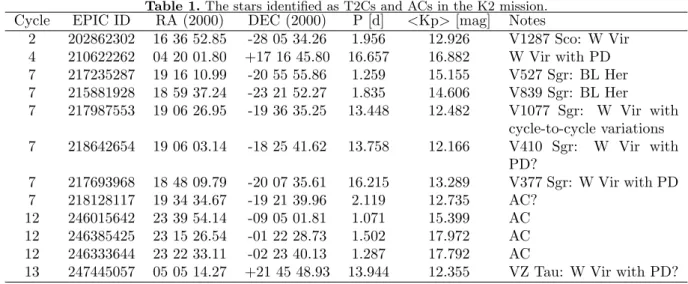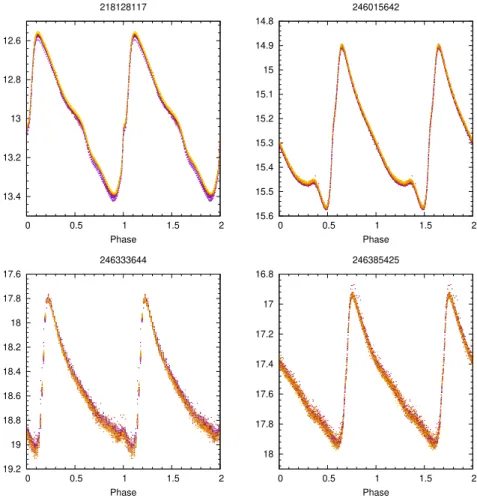Stars and their variability observed from space
C. Neiner, W. W. Weiss, D. Baade, R. E. Griffin, C. C. Lovekin, A. F. J. Moffat (eds)
TYPE II CEPHEIDS IN THE KEPLER K2 MISSION
M. I. Jurkovic
1,2, E. Plachy
2,3, L. Moln´ ar
2,3, M. A. T. Groenewegen
4and R. Szab´ o
2,3Abstract.
Type II Cepheids (T2Cs) are old, low-mass (0.5 M) stars. They mainly pulsate in a radial mode, but recent discoveries have shown that there are first overtone pulsators among them, and they can exhibit a phenomenon called ”period-doubling”. They are separated into three subgroups according to their pulsation periods: BL Her, 1<P [d]<4, W Vir: 5<P [d]<20, RV Tau: 20<P [d]<150. Anomalous Cepheids (ACs) have an average mass of 1.2 M, and they pulsate in a fundamental mode and/or[?] in the first overtone. Their periods are in the range from 0.4 to 2.4 days. The Kepler space telescope’s original field contained only a single RV Tau star, DF Cyg, but that changed during the K2 mission. Here we present the 12 stars that were observed in Campaigns 1 – 14 of the K2 mission. We have found Type II Cepheids in the sample that show ”period doubling”, and four possible anomalous Cepheids among the 12 stars.
Keywords: Stars: variables: Cepheids
1 Introduction and Data
The data for the Kepler K2 mission were downloaded from the Mikulski Archive for Space Telescopes database (MAST, https://archive.stsci.edu) and analysed with the Extended Aperture Photometry (EAP, Plachy et al. 2017). For each star, an individual aperture was applied, as seen in Figure 1 on the right for the star 218128117 from Campaign 7, where the telescope made significant jumps during the observing run. We have also used the magnitudes from the EPIC Variability Extraction and Removal for Exoplanet Science Targets (EVEREST, Luger et al. (2016)) pipeline for comparison. Table 1 gives the basic information about each star in the sample.
Table 1.The stars identified as T2Cs and ACs in the K2 mission.
Cycle EPIC ID RA (2000) DEC (2000) P [d] <Kp>[mag] Notes
2 202862302 16 36 52.85 -28 05 34.26 1.956 12.926 V1287 Sco: W Vir 4 210622262 04 20 01.80 +17 16 45.80 16.657 16.882 W Vir with PD 7 217235287 19 16 10.99 -20 55 55.86 1.259 15.155 V527 Sgr: BL Her 7 215881928 18 59 37.24 -23 21 52.27 1.835 14.606 V839 Sgr: BL Her 7 217987553 19 06 26.95 -19 36 35.25 13.448 12.482 V1077 Sgr: W Vir with
cycle-to-cycle variations 7 218642654 19 06 03.14 -18 25 41.62 13.758 12.166 V410 Sgr: W Vir with
PD?
7 217693968 18 48 09.79 -20 07 35.61 16.215 13.289 V377 Sgr: W Vir with PD 7 218128117 19 34 34.67 -19 21 39.96 2.119 12.735 AC?
12 246015642 23 39 54.14 -09 05 01.81 1.071 15.399 AC 12 246385425 23 15 26.54 -01 22 28.73 1.502 17.972 AC 12 246333644 23 22 33.11 -02 23 40.13 1.287 17.792 AC
13 247445057 05 05 14.27 +21 45 48.93 13.944 12.355 VZ Tau: W Vir with PD?
1 Astronomical Observatory Belgrade, 11060 Belgrade, Serbia, Konkoly Observatory
2 Research Centre for Astronomy and Earth Sciences, H-1121 Budapest, Hungary
3 MTA CSFK Lend¨ulet Near-Field Cosmology Research Group
4 Koninklijke Sterrenwacht van Belgie, 1180, Brussels, Belgium
c
Stars from Space
438 Stars and their variability observed from space
2 Results
Our results can be summarized as follows:
• We have found four anomalous Cepheids (see Fig. 1).
• Two W Virginis stars show ”period doubling” (PD). Star 217987553 does not show PD, but it does have an additional modulation (cycle-to-cycle variation).
• For two additional stars further analysis needs to be done to confirm if there is a PD in their light curves.
12.6
12.8
13
13.2
13.4
0 0.5 1 1.5 2
Phase 218128117
14.8 14.9 15 15.1 15.2 15.3 15.4 15.5 15.6
0 0.5 1 1.5 2
Phase 246015642
17.6 17.8 18 18.2 18.4 18.6 18.8 19 19.2
0 0.5 1 1.5 2
Phase 246333644
16.8 17 17.2 17.4 17.6 17.8
18
0 0.5 1 1.5 2
Phase 246385425
Fig. 1.The phased light curves of ACs in the K2 mission previously identified as T2Cs.
This project has been supported by the NKFIH K-115709 and PD-121203 grants of the Hungarian National Research, Development and Innovation Office and the Lend¨ulet program of the Hungarian Academy of Sciences, project No. Lend¨ulet LP2018-7/2019. MIJ acknowledges financial support from the Ministry of Education, Science and Technological Development of the Republic of Serbia through the project 176004. Research partially supported by the D´elvid´ek´ert Kiss Foundation and Maria Lugaro’s OTKA/NKFI-6 grant. LM was supported by the Premium Postdoctoral Research Program, EP by the J´anos Bolyai Research Scholarship of the Hungarian Academy of Sciences.
References
Luger, R., Agol, E., Kruse, E., et al. 2016, AJ, 152, 100
Plachy, E., Klagyivik, P., Moln´ar, L., S´odor, ´A., & Szab´o, R. 2017, in EPJ Web of Conferences, Vol. 160, EPJ Web of Conferences, 04009

